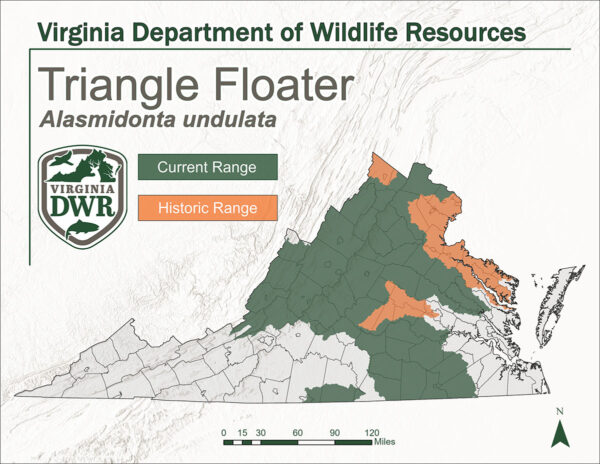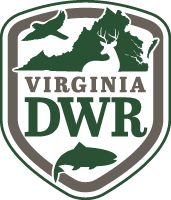Triangle Floater encountered during a snorkel survey
A subadult Triangle Floater tagged for release
Triangle Floater encountered during a SCUBA survey of the Nottoway River
Fact File
Scientific Name: Alasmidonta undulata
Classification: Freshwater Mussel, Family Unionidae
Conservation Status:
- Species of Greatest Conservation Need-Tier 4a on the Virginia Wildlife Action Plan
Size: 75 mm
Identifying Characteristics
- Thick, inflated shell; triangular in shape
- The anterior end is round, and the posterior end is pointed
- The ventral margin is round
- The outer covering of the shell (periostracum) is yellowish-green, darkening to black with age
- Rays are variable in width, and green to black in color
- The inner portion of the shell (nacre) may be white, pink, or red with iridescence
Habitat
The Triangle Floater inhabits small streams to large rivers and lakes. It is typically found in areas with slower moving current, and a stable substrate composition of coarse gravel and sand.
Distribution
The Triangle Floater is widely distributed throughout Virginia, with populations occurring in the Chowan, James, Potomac, Rappahannock, Roanoke, and York River basins.

Life History
Freshwater mussels have a very unique life cycle. Parasitic larvae, called glochidia, develop in the gills of the female mussel. Once mature, the glochidia are expelled from the gills of the mussel and must attach to the gills of a suitable host fish, where they complete their transformation into a juvenile mussel. They then detach from the fish and begin their free-living existence on the river bottom.
Some freshwater mussels are host-specialists, meaning that metamorphosis can only occur on a limited number of closely related fish species, while others are host-generalists, with the ability to complete their life cycle using many different species. The Triangle Floater uses a wide variety of fish hosts including Common Shiner (Luxilus cornutus), Eastern Blacknose Dace (Rhinichthys cataractae), Largemouth Bass (Micropterus nigricans), Pumpkinseed (Lepomis gibbosus), Slimy Sculpin (Cottus cognatus), and White Sucker (Catostomus commersoni).
Conservation
Both the Virginia Fisheries and Aquatic Wildlife Conservation Center (VFAWC) and Virginia Tech’s Freshwater Mollusk Conservation Center (FMCC) have propagated this species to augment populations throughout the Potomac River basin. Additionally, routine monitoring of Triangle Floater at release sites helps determine the success of these efforts and guide future management decisions.
Special Considerations
Freshwater mussels are extremely imperiled organisms. DWR regulates the take and possession of freshwater mussels occurring within the state. It is unlawful to take mussels from any inland waters in the Commonwealth except as provided for in §§ 29.1-418 and 29.1-568 of the Code of Virginia.
Last updated: July 20, 2025
The Virginia Department of Wildlife Resources Species Profile Database serves as a repository of information for Virginia’s fish and wildlife species. The database is managed and curated by the Wildlife Information and Environmental Services (WIES) program. Species profile data, distribution information, and photography is generated by the Virginia Department of Wildlife Resources, State and Federal agencies, Collection Permittees, and other trusted partners. This product is not suitable for legal, engineering, or surveying use. The Virginia Department of Wildlife Resources does not accept responsibility for any missing data, inaccuracies, or other errors which may exist. In accordance with the terms of service for this product, you agree to this disclaimer.

